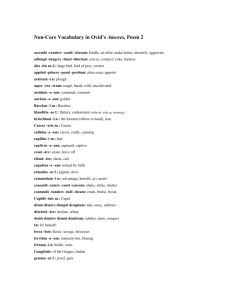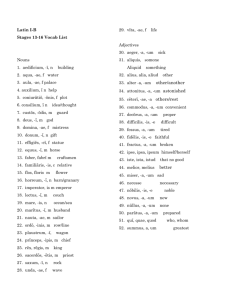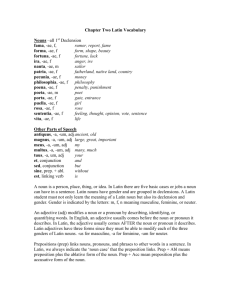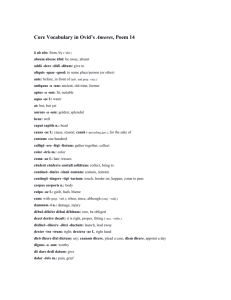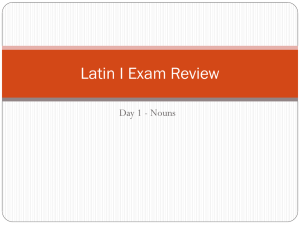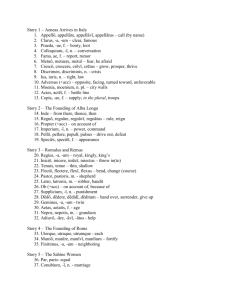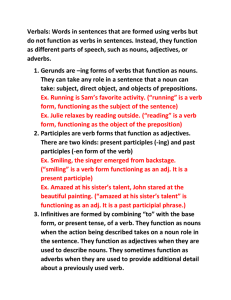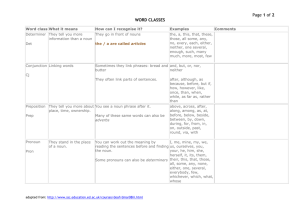Latin I Unit 2 Test Review Sheet
advertisement
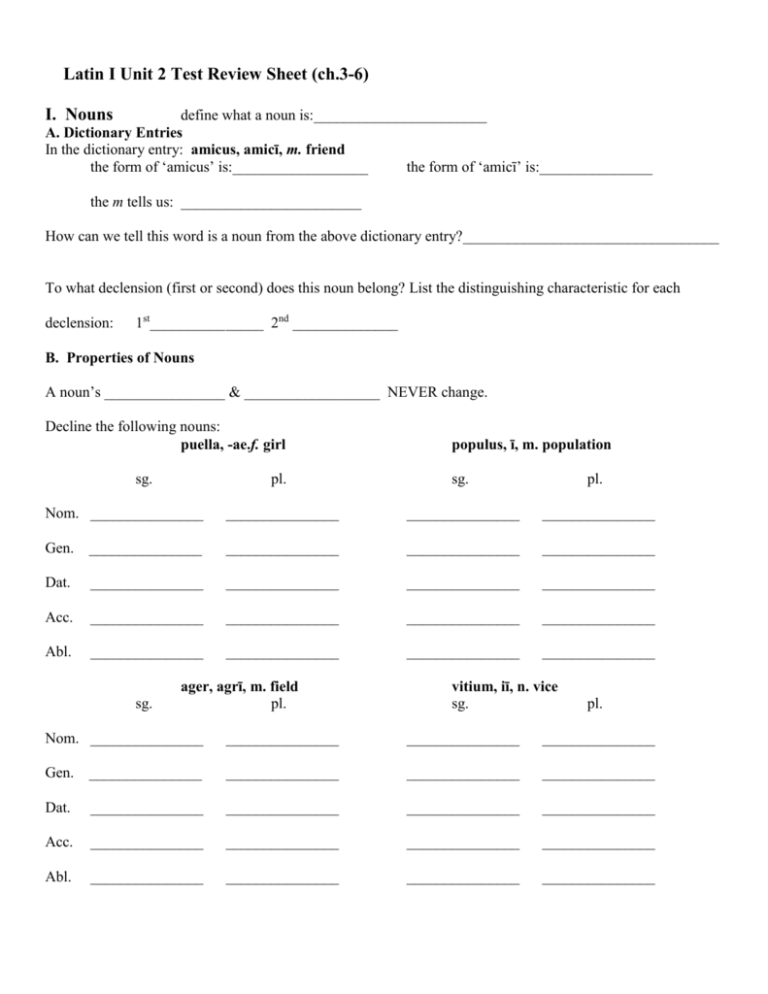
Latin I Unit 2 Test Review Sheet (ch.3-6) I. Nouns define what a noun is:_______________________ A. Dictionary Entries In the dictionary entry: amicus, amicī, m. friend the form of ‘amicus’ is:__________________ the form of ‘amicī’ is:_______________ the m tells us: ________________________ How can we tell this word is a noun from the above dictionary entry?__________________________________ To what declension (first or second) does this noun belong? List the distinguishing characteristic for each declension: 1st__________ _____ 2nd ______________ B. Properties of Nouns A noun’s ________________ & __________________ NEVER change. Decline the following nouns: puella, -ae.f. girl sg. populus, ī, m. population pl. sg. pl. Nom. _______________ _______________ _______________ _______________ Gen. _______________ _______________ _______________ _______________ Dat. _______________ _______________ _______________ _______________ Acc. _______________ _______________ _______________ _______________ Abl. _______________ _______________ _______________ _______________ sg. ager, agrī, m. field pl. vitium, iī, n. vice sg. pl. Nom. _______________ _______________ _______________ _______________ Gen. _______________ _______________ _______________ _______________ Dat. _______________ _______________ _______________ _______________ Acc. _______________ _______________ _______________ _______________ Abl. _______________ _______________ _______________ _______________ What does the Nominative do in a sentence (its grammatical function/syntax)?___________________________ What word do we use to translate the Genitive Case? _______________________________ What word (or words) do we use to translate the Dative Case?___________________________ What does the Accusative Case do in a sentence (its grammatical function/syntax)?_______________________ What word (or words) do we use to translate the Ablative Case?___________________________ What is meant by “the Subject of a sentence”?__________________________________ What is meant by “the Direct Object of a sentence”?_________________________________ II. Verbs A. General What is a verb?__________________________________________ What does ‘conjugating a verb’ mean?_____________________________________________________________ Provide the appropriate English pronoun: 1st person singular ____________ 1st person plural = ____________ 2nd person singular = ____________ 2nd person plural = ____________ 3rd person* singular = ____________ 3rd person plural = ____________ *other than just these pronouns, what else can be the subject of a 3 rd person noun? _____________________________ How do you find the present stem of a Latin verb?______________________________________ B. Dictionary Entries In the dictionary entry: amō, amāre, amāvī, amātum These four pieces of the verb are called: principle parts the first principle part is: ___________tense, ________person, singular/plural (circle one) the second principle part is: _________________ and is translated _____________________ When a verb is listed with a (1) after it, e.g. satiō (1), what does that mean?_____________________ What are the principle parts of all (1) verbs? ____________ _____________ ____________ ____________ C. Conjugating Verbs Tense tells us what about the action of the sentence?________________________________________ You know 3 tenses in Latin, name them: _________________ _____________________ ________________ Conjugate the following verb in all 3 tenses: amō, amāre, amāvī, amātum sg. pl. 1st _______________________________________ _______________________________________ 2nd _______________________________________ _______________________________________ 3rd _______________________________________ _______________________________________ sg. pl. 1st _______________________________________ _______________________________________ 2nd _______________________________________ _______________________________________ 3rd _______________________________________ _______________________________________ sg. pl. 1st _______________________________________ _______________________________________ 2nd _______________________________________ _______________________________________ 3rd _______________________________________ _______________________________________ translate one: ___________________________ translate one: __________________________ translate one: ___________________________ Imperative Latin ___________________________ __________________________ English ___________________________ __________________________ Conjugate the following verb in all 3 tenses: habeō, habēre, habuī, habitum sg. pl. 1st _______________________________________ _______________________________________ 2nd _______________________________________ _______________________________________ 3rd _______________________________________ _______________________________________ translate one: ___________________________ sg. pl. 1st _______________________________________ _______________________________________ 2nd _______________________________________ _______________________________________ 3rd _______________________________________ _______________________________________ sg. pl. 1st _______________________________________ _______________________________________ 2nd _______________________________________ _______________________________________ 3rd _______________________________________ _______________________________________ Latin ___________________________ Imperative __________________________ English ___________________________ translate one: __________________________ translate one: ___________________________ __________________________ D. Irregular Verb: sum, esse, fuī, futūrum Is this a linking verb?___________________ why do we care?________________________ (p.26-27) Conjugate and Translate verb in the Present Tense: Latin sg. pl. 1st _______________________________________ _______________________________________ 2nd _______________________________________ _______________________________________ 3rd _______________________________________ _______________________________________ English sg. pl. 1st _______________________________________ _______________________________________ 2nd _______________________________________ _______________________________________ 3rd _______________________________________ _______________________________________ III. Adjectives define what an adjective is:____________________ A. Dictionary Entries In the dictionary entry: bonus, bona, bonum How can you tell this is an adjective from the dictionary entry?_______________________________________ Please list the form (case, gender, number) for: bonus ___________________ bona_________________ bonum___________________ B. Usage Adjectives must agree with the nouns they modify in these 3 things: 1. 2. 3._____________________________ Do adjectives always have the same endings as the nouns they modify? Explain. _____________________________________________________________________________________ List the 3 ‘sneaky masculines’ you know:1.________________2._______________3._______________ What is a Substantive Adjective?______________________________ translate each word substantively: bonus__________________ bona__________________ bonum______________________ bonī____________________ bonārum ________________ multa_______________________ IV. Prepositions Prepositions tell us how different parts of the sentence relate to each other. List all the prepositions you know and what case each one takes: prep case definition 1.__________________+ ____________________ __________________________ 2.__________________+ ____________________ __________________________ 3.__________________+ ____________________ __________________________ 4.__________________+ ____________________ __________________________ V. Nouns vs. Verbs List the differing traits of Nouns and Verbs in Latin (how they’re different) nouns verbs VI. Translating A. Latin to English 1. look for the verb 2. find the subject (it’s in the Nominative Case, ends with: -a, -us, -um, -ae, -ī, -a) 3. find the direct object (it’s in the Accusative Case, ends with: -am, -um, -ās, -ōs, -a) 4. Put your English words in the order: Subject Verb Object 5. determine the case of the rest of the words (when in doubt try translating in all the different ways and pick the one that makes the most sense) B. English to Latin 1. Look for clues in the English, such as: of, to/for, with 2. Use the clues to determine the grammatical function/case of each noun. 3. Determine which adjectives are describing which noun and change it to agree with its noun. 4. Determine the subject (who’s doing the action/what English word comes before the verb) and tense of the verb in order to conjugate it correctly. 5. Determine the Direct Object of the sentence (the English word that comes after the verb/the noun that is being acted upon by the verb) and put it into the Accusative Case. Vocabulary nouns: adulēscentia, -ae, f. ager, agrī, m agricola, -ae, m. amīca, -ae, f. amīcus, -ī, m. animus, -ī, m. bāsium, -iī, n. bellum, -ī, n. caelum, -ī, n. cōnsilium, -iī, n. culpa, -ae, f. cūra, -ae, f. dōnum, -ī, n. exitium, -iī, n. fama, famae, f. fēmina, -ae, f. filia, -ae, f. filius, -iī, m. forma, formae, f. fortuna, fortunae, f. gloria, -ae, f. īra, īrae, f. magister, -trī, m. mora, -ae, f. nauta, nautae, m. nihil (indeclinable) numerus, -ī, m. oculus, -ī, m. officium, -ī, n. ōtium, -iī, n. patria, -ae, f pecunia, -ae, f. perīculum, -ī, n. philosophia, -ae, f. poena, -ae, f. poeta, -ae, m. populus, -ī, m. puella, puellae, f. puer, puerī, m. remedium, -iī, n. rosa, -ae, f. sapientia, -ae, f. sententia, -ae, f. verbum, -ī, n. vir, virī, m. vita, vitae, f. pronouns: mē (acc/abl) quid tē (acc/abl) adjectives: antiquus, -a, -um avārus, -a, -um bellus, -a, -um bonus, -a, -um hūmanus, -a, -um līber, lībera, līiberum magnus, -a, -um malus, -a, -um meus, -a, -um multus, -a, -um noster, nostra, nostrum parvus, -a, -um paucī, -ae, -a pulcher, pulchra, pulchrum Romanus, -a, -um sānus, -a, -um stultus, -a, -um tuus, -a, -um vērus, -a, -um herī hodiē non saepe satis semper tum verbs: amō, amāre, amāvī, amātum cēnō (1) cogitō, cogitāre, cogitāvī, cogitātum conservō, conservāre, conservāvī, conservātum culpō (1) debeō, debēre, debuī, debītum dō, dāre, dedīi, dātum errō, errāre, errāvī, errātum habeō, habēre, habuī, habitum iuvō (1) laudō, laudāre, laudāvī, laudātus maneō, -ēre, mansī, mansum moneō, monēre, monuī, monītum remaneō, -ēre, remansī, remansum salveō, salvēre satiō (1) servō, servāre, servāvī, servātum sum, esse, fuī, futūrum superō (1) terreō, terrēre, terruī, terrītum valeō, valēre, valuī, valiturum videō, vidēre, vidī, visum vocō, vocāre, vocāvī, vocātum Interjections O adverbs crās conjunctions et igitur (postpositive) quandō sed si prepositions de (+abl) in (+abl) propter (+acc) sine (+abl) Suffixes -ne (added to end of the first word in a question)
